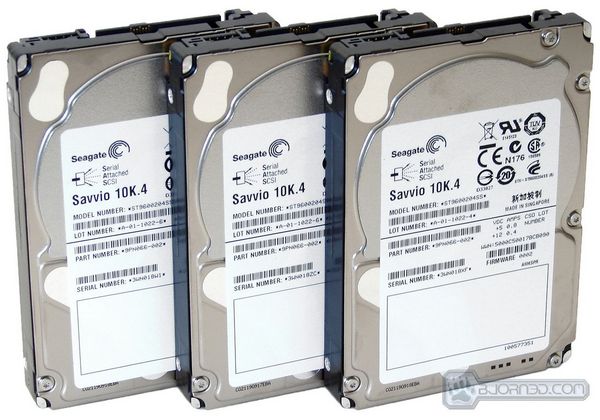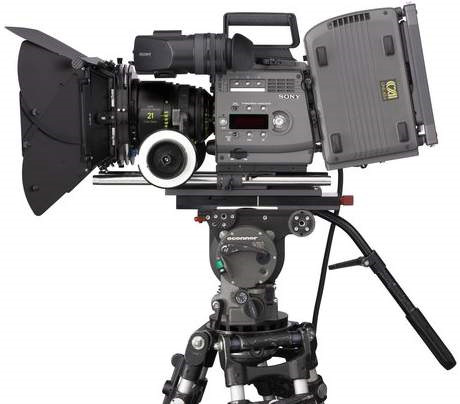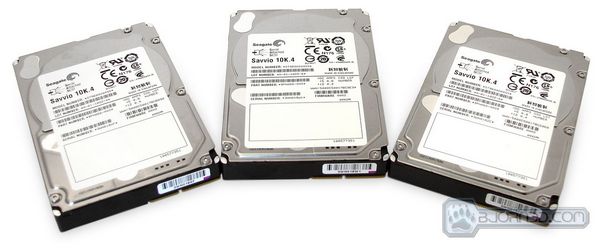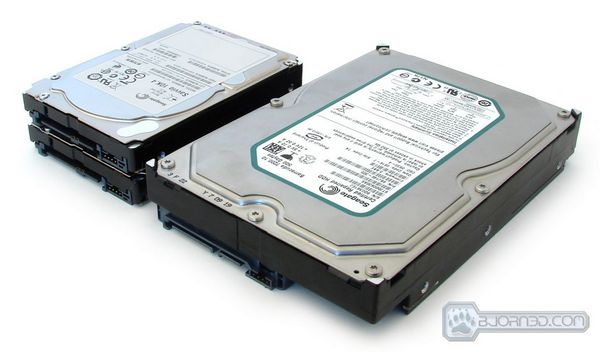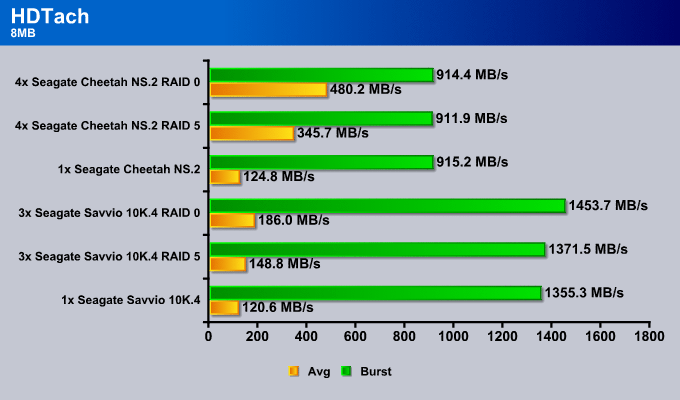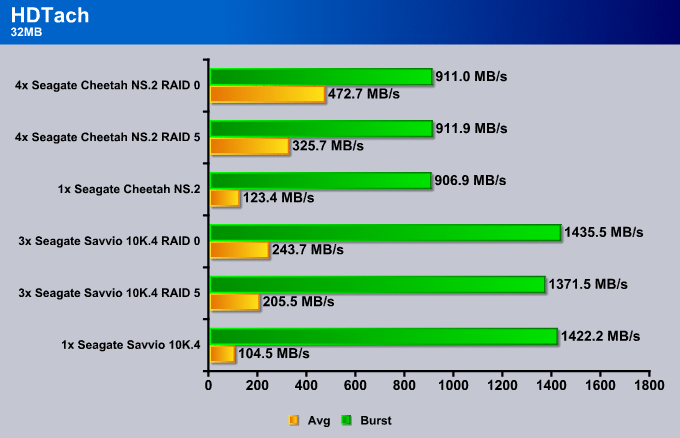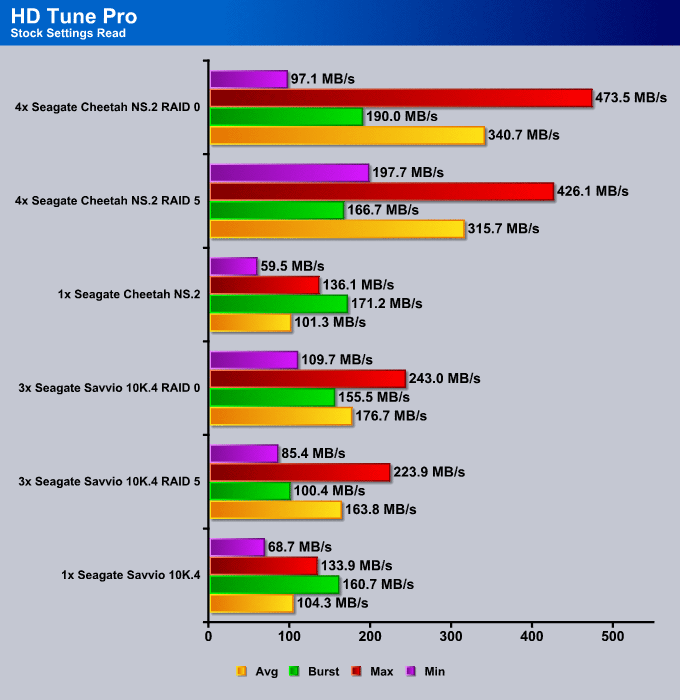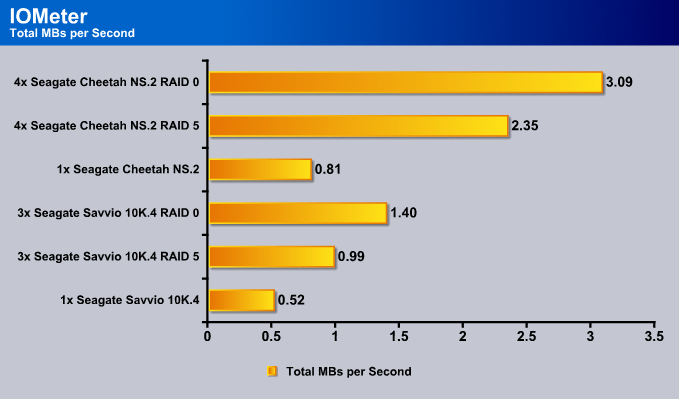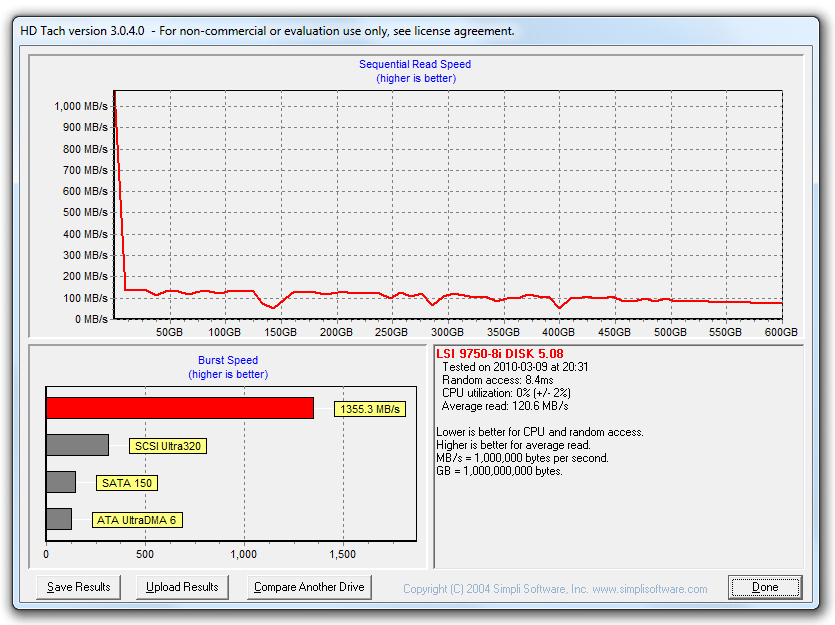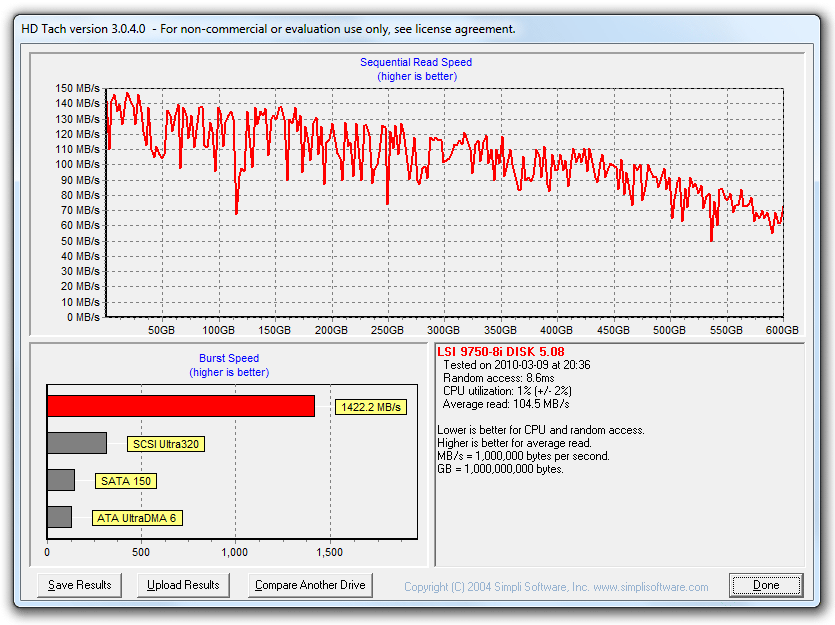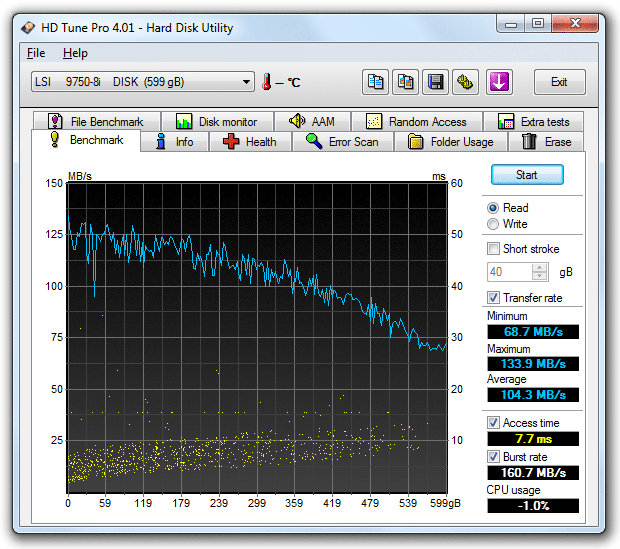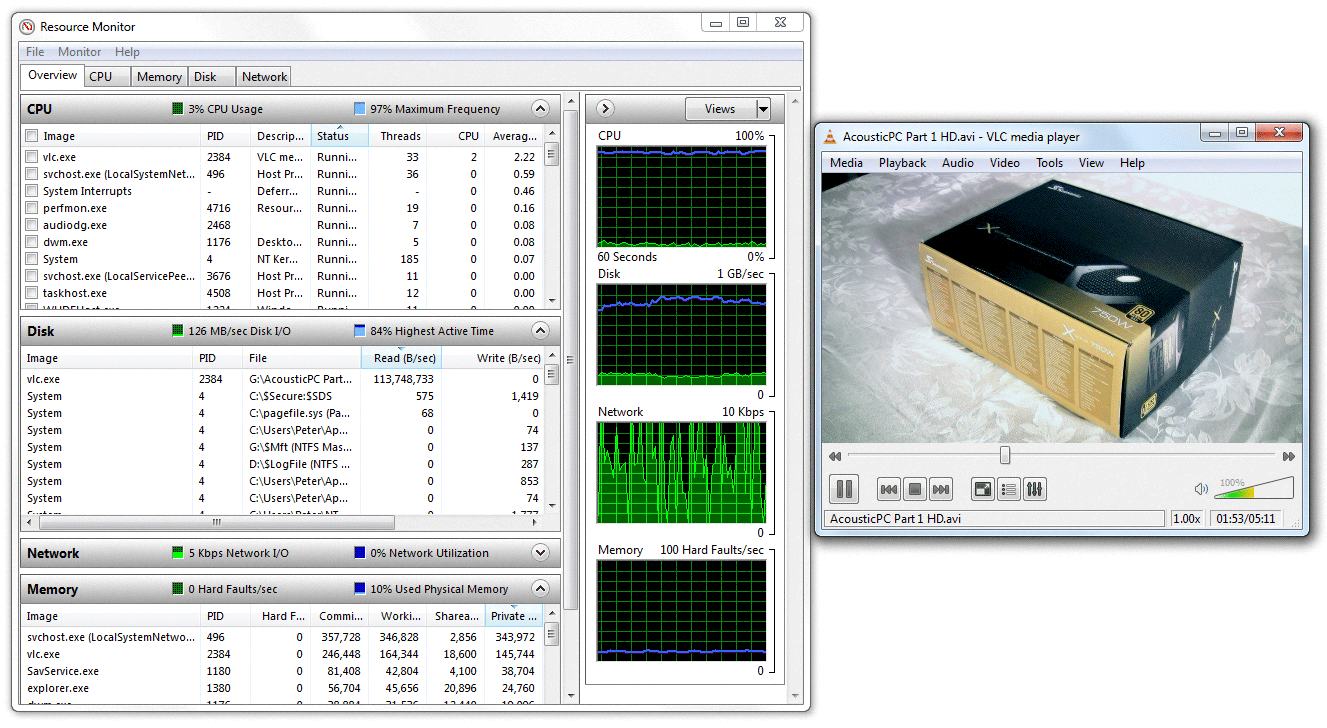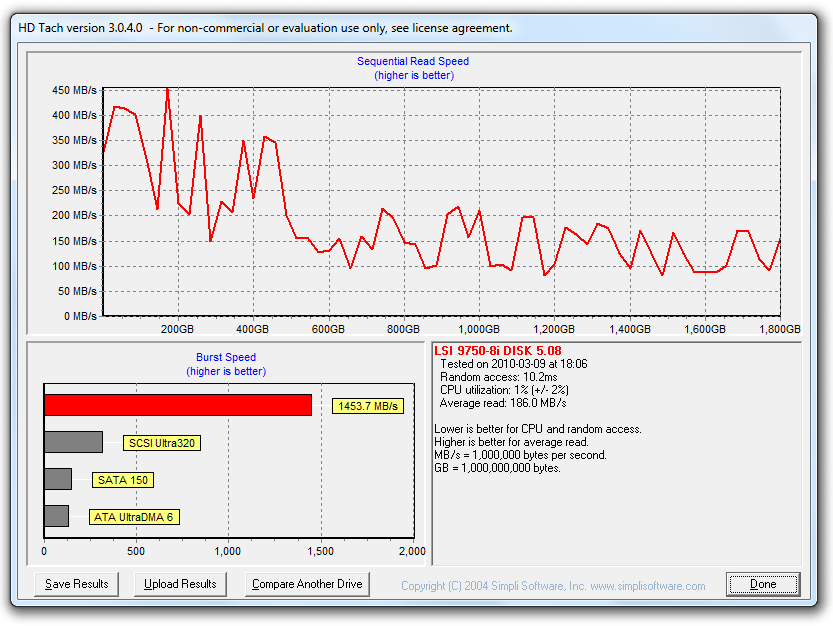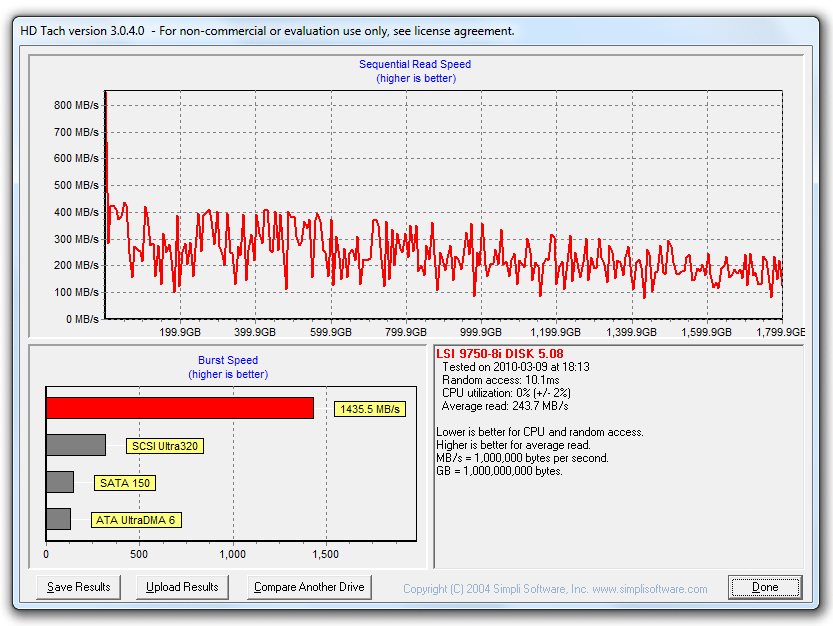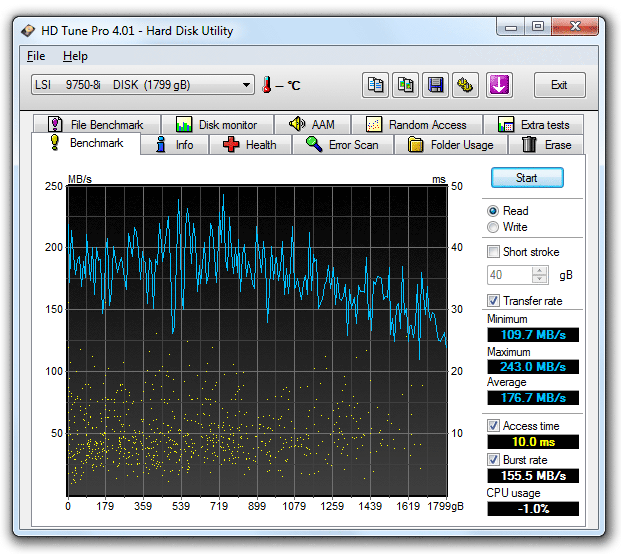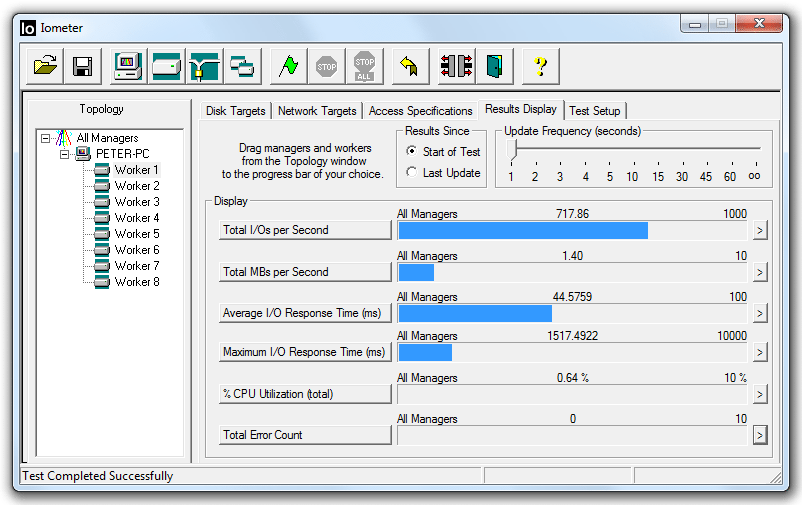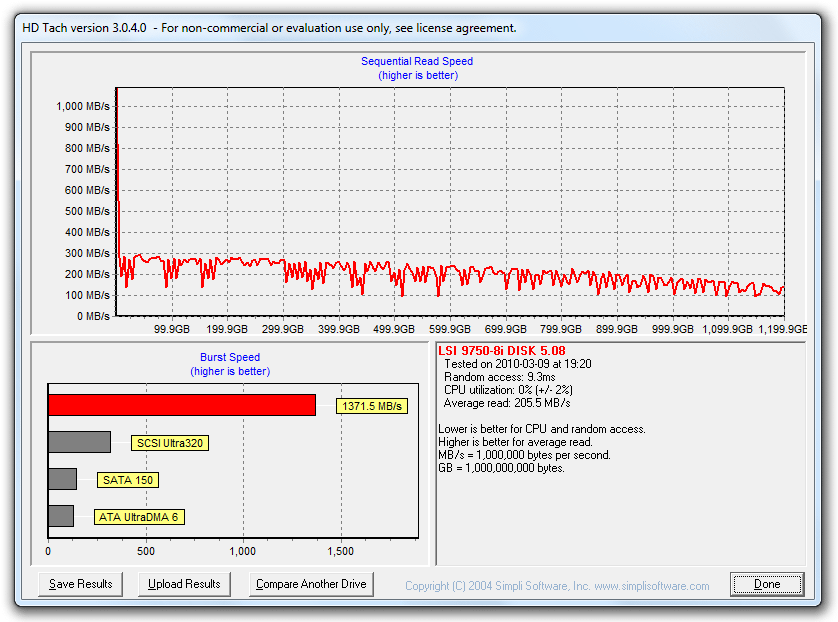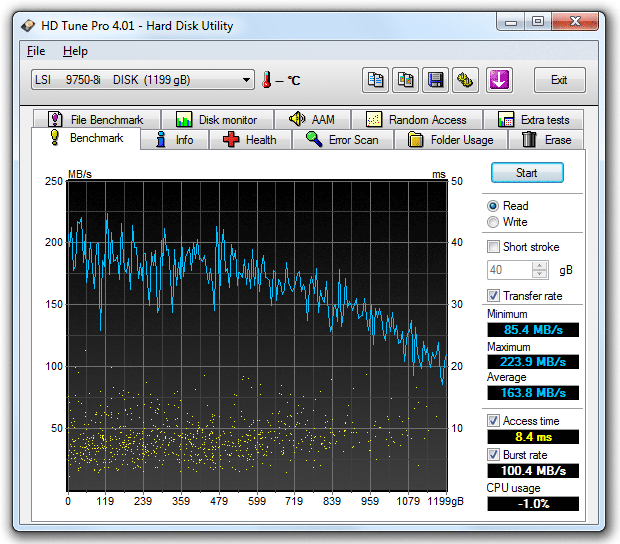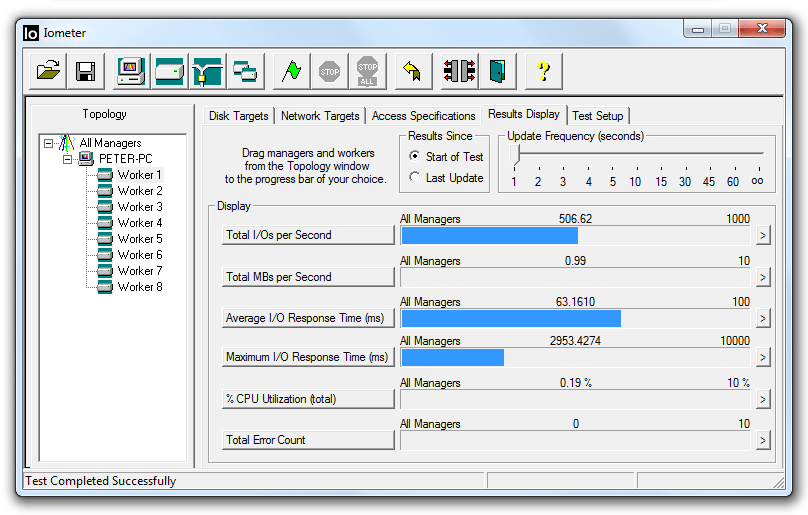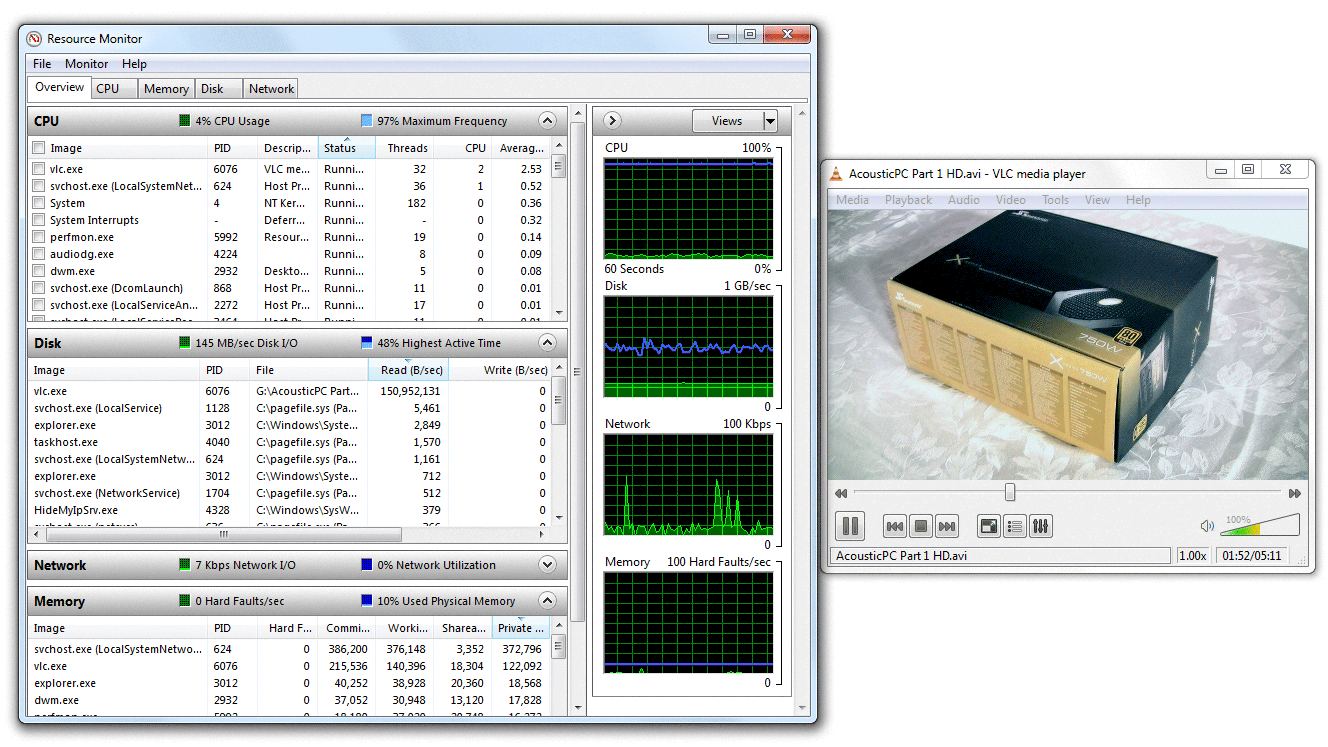The Seagate Savvio 10K.4 Serial Attached SCSI hard drives are the first to be the largest capacity (600GB), and smallest form factor (2.5 ”) server hard drives available, making capacity and speed an issue of the past for server based systems.
Introduction
A few weeks ago, we have taken a look at Seagate’s Cheetah NS.2 SAS hard drives, which were standard 3.5″ form factor 6Gb/s 10,000RPM 600GB Serial Attached SCSI hard drives. This time Seagate was kind enough to let us test out their latest Serial Attached SCSI drives, their Savvio 10K.4 hard drives. These drives come in different capacities including 450GB and 600GB, but what makes them so special is that they are 2.5″ form factor, which is what you would use in laptop based system. This is the first time we see a 6Gb/s 10,000RPM 600GB SAS hard drive at such small form factor at this capacity. In my opinion, it is just unbelievable how far we got over the past few years. This means that we are now able to store more data in smaller compartments. Many businesses run into problems where they would need larger server rooms in order to have the capacity they need for their business requirements as well as to make sure that all the data is also backed up. By lowering the size of the drives and maintaining the same capacity, speed, and reliability, businesses can now have the same amount of capacity for their data with half or triple the amount of space they would have needed previously. This allows customers to use the extra space for extra backup solutions or other purposes. Or of course, since there is less space required, the overall cost of the server room can be lowered due to less space needed.
Excerpt taken from previous Seagate Cheetah NS.2 Review but modified to fit with this review:
“The first thing that you will find very interesting is that this hard drive uses the new 6.0Gb/s interface design, which allows for double the throughput speed then what was possible previously on the older 3.0Gb/s interface. Many new motherboards are coming out with SATA slots that already use the 6.0Gb/s interface, but the difference is that these hard drives are Serial attached SCSI based and not SATA, so you would not be able to attach these drives to just the motherboard, unless the motherboard comes with a dedicated SAS controller. Another interesting fact is that even though these new motherboards are already out with the new 6.0Gb/s interface, most motherboards are only able to achieve this speed by limiting the system to only non-SLI or non-Crossfire based systems, meaning, you cannot use more than one video card. It will not only limit the user on the video cards, but it will also lower the PCI-E slot speeds to 8x, which means that there will be less performance from the video card. Now just like I have mentioned before, the Seagate Savvio 10K.4 hard drives are SAS drives, so in order to get these bad boys running, we need a special RAID controller card, that is capable of Serial attached SCSI’s and the new 6.0Gb/s interface. 3.0Gb/s RAID cards will work, but the performance will be lowered. In this case, we will be using LSI’s 3ware SAS 9750-8i RAID controller card to accomplish the most out of our video editing. Since these RAID cards work separately from the motherboard, except they use the PCI-E slots, they do not have any limitations like current motherboards do.
The second interesting part of this hard drive is that it runs at 10,000RPM.This not only allows for lower access times, but also for faster transfer and read speeds. The combination of the new 6.0Gb/s interface and the 10,000RPM capability allows for better performance then what we have already seen.
And finally, the main big difference between SAS drives and SATA drives is the way they access the information. SATA drives access information mainly under Sequential Access Pattern, while SAS drives access information through Random Access Patterns. If writes are sequential on a disk, it minimizes seek times on the hard drive, and the data can be written much faster, while random access results in many seeks across the hard drive that can slow down the process dramatically. This brings up another question, why would SAS drives be Random Access Pattern based if they could be Sequential Access Pattern based for more performance on tasks like video editing? Well, the answer lies behind the reason for building SAS drives. SAS drives were mainly built for “transactional applications that require constant and immediate access to data. These applications, ranging from highly critical databases to email servers, rely on exceptional performance, reliability, and availability. Online storage is powered on 24x 7, handles mostly random requests, and has high IOPS and high duty cycles” (LSI) So while its main purpose is not made for something a Desktop user would use it for, its exceptional performance with the help of a hardware based RAID card can drastically improve performance even though the drives are set to Random Access Patterns.”
| Product Name | Price |
| Seagate Cheetah NS.2 600GB 3.5″ SAS 6Gb/s Internal Hard Drive | $533 |
| Seagate Savvio 10K.4 600GB 2.5″ SAS 6Gb/s Internal Hard Drive | $616 |
| LSI 3ware SAS 9750-8I KIT 4PORT 6GB SATA+SAS PCIE 2.0 512MB | $573 |
Understanding Film
Before we can explain why fast hard drives are very important in film making, it is important to understand how film works. If you have no interest in film or how these drives would perform with film, please skip ahead to the next page. If you are interested about Film and would like to know more about how SAS drives can help, please continue reading this page.
It is important to understand that there are many different formats, and ways video can be recorded. For someone working in the Green Screen industry, they know that in order to get perfect green screen footage that they can later use in their high-budget filming, they need perfect 4:4:4 color sampling uncompressed video. Now before I go into details, let me just explain how most of the consumer, prosumer, and Hollywood cameras record video.
The first picture we see is a picture of a Canon 7D Digital SLR camera beefed up with some filming accessories from Zacuto USA. However, Canon’s new DSLR camera line-up is also refered to as “HDSLR” because they are able to record High-Definition video. What’s interesting about this is that even pro camcorders in the $3000+ range don’t have such a large sensor as the Canon 7D does. The Canon 7D has a 22.3 x 14.9 mm CMOS sensor, while the sensor on the second camera in the picture only has a 1/3″ interline-transfer CCD sensor. The film industry for almost a decade now has been using 35mm or larger film in order to create their stunning Hollywood look we see in their movies, so one of the key features for independent film makers is to try to get a camera that has a 35mm (full-frame) sensor or something very similar to that. The Canon 5DMarkII DSLR camera happens to have a full-frame sensor which would give independent film makers excellent video quality and they would also be able to change their lenses for different shots, the only problem is that these cameras go through extreme compression that butchers the quality of the video in order to record the video on smaller SD or CF memory cards.
So the first camera in the pictures uses a 4:2:0 color subsampling for recording, while the second camera uses 4:2:2 color subsampling for recording. Finally the last camera, the Sony CineAlta F35 uses a 4:4:4 color sampling and uses a full 35mm sensor for video recording. What’s the difference in price between these cameras? Well the first one if we exchange the 7D to the 5DMarkII camera that uses a 35mm sensor would cost around $3,000 with a kit lens. The second camera would cost around $12,000+ because it requires a special 35mm adapter in order to use professional SLR lenses to achieve a film look. However, usually using a 35mm adapter also slightly lowers the quality of the video because you cannot achieve excellent focus that you would with an actual 35mm sensor. And finally the last camera which is a Hollywood camera would cost well over $150,000+ with extra expenses if you want to modify it.
What is 4:4:4, 4:2:2, 4:2:0, and Green Screening?
“Because of storage and transmission limitations, there is always a desire to reduce (or compress) the signal. Since the human visual system is much more sensitive to variations in brightness than color, a video system can be optimized by devoting more bandwidth to the luma component (usually denoted Y’), than to the color difference components Cb and Cr. The 4:2:2 Y’CbCr scheme for example requires two-thirds the bandwidth of (4:4:4) R’G’B’. This reduction results in almost no visual difference as perceived by the viewer.” -Wikipedia
Basically what happens in recording is that under 4:4:4, the video is completely uncompressed, where each pixel gets the royal treatment. So perfect resolution, perfect color, and perfect luma. With this, green screening is perfect, so when the green color is taken out from behind an object, there is no sign or having any green on the edges of the video. What engineers noticed was that the eye can’t see quick changes in color so to save on bandwidth, they would cut the color sampling in half, with the color only updating on every second pixel, which is called 4:2:2. Visually there is no difference in quality, but when taken into an editing software and heavy effects are added, the lower quality can be noticed. However, the engineers, took this even further, and cut down the color sampling to 4:2:0 where the color would only update every second pixel, but the luma channel would be cut down in resolution even further. Under this color subsampling, visually it becomes visible that there is a difference between 4:2:2 and 4:2:0, but overall in a moving image it is not too bad especially when recording in HD quality. This is what most DV, HDV, and AVCHD video formats use.
(Screenshots taken from Hollywood Camera Work – Visual Effects For Directors DVD)
These three images show clearly what happens when green screen is used with a lower end camera with a high compression. The first two images were showed how a DV, HDV, AVCHD or these similar formats would work with green screen, and the last picture shows the actual 4:4:4 color sampling that you get with professional Hollywood cameras like for example the Sony CineAlta F35 or a RED One camera. The 4:4:4 color sampling shows how fine detail is left in the hair after removing the green screen from behind the actress. On the first picture we see something that is called a four pixel stair-casing. Depending on the quality, a 4:2:2 color sampling would produce a two pixel stair-casing. Since 4:4:4 has information about everything in every pixel, we don’t see the pixel stair-casing. There are applications that can get rid of the pixel stair-casing with the cost of reducing detail in the actual green screened video, which we can see on the middle picture. So as a conclusion 4:4:4 is what is needed for proper professional green screening.
How can Seagate’s SAS drives help in Filming Studios?
Since most people could be on a budget where money is a problem, they will most likely buy a camera that is 4:2:0 or 4:1:1 based. Believe it or not, even expensive camcorders that cost around $3000-$9000 still use 4:1:1 or 4:2:0 color subsampling. But what makes HDSLR cameras like the 5DMarkII so special that no other camera can do is that they can record in 24p (23.967fps) which is film frame rate on a 35mm sensor. They also record at Full-HD quality at 1080p resolution, and of course the biggest change is that you can use lots of different lenses. You most likely are not able to do all of these on even more expensive cameras besides a professional 35mm adapter which costs a few thousand dollars.
What can be done though is that if there is a fast enough recording unit, you can record uncompressed 4:2:2 video even with a HDSLR cameral like the 5DMarkII through its HDMI output connector. Since the camera doesn’t have to record to a CF or SD memory card anymore, it does not have to go through the heavy H.264 codec compression. Usually uncompressed 4:2:2 footage is quite heavy on transfer speeds, so for this task you need at least 100-150mb/s transfer rate in recording. By having a system with a few Seagate Savvio or Cheetah drives in your studio, you are able to record uncompressed 220Mbps lossless 1920×1080 HD video which is about 22x higher in quality than current DVDs. However, we are still recording at 4:2:2 and not 4:4:4. There is a way to get our footage to 4:4:4 for ultimate Hollywood quality green screening, however; we need to convert our HD video with uncompressed lossless settings to half of its resolution so the color pixels that were spread to 2 pixels would now fit onto each pixel. The downside to this process is that your video is no longer HD resolution, but you do get the quality that you would get with a $150,000+ camera.
All you would need is a small form factor PC that can use a RAID card and a few SAS drives for ultimate capacity for video. With three Seagate Savvio 10K.4 600GB hard drives we would have a total storage of 1800GBs or 1.8TB. Let’s just say our video is being recorded at a constant of 100MB/s, then 1,800,000MB/100MB would equal to 18,000 seconds of video. This means 18,000sec / 60sec / 60min = 5 hours of continuous uncompressed HD video recording. All of a sudden 1.8TBs of storage becomes a small amount when we get into such tasks.
So if we compare perhaps a camera that costs $150,000+ to a home setup that could cost around $10,000, all of a sudden we have a very similar setup that costs 15x less than what you would invest in a professional Hollywood camera.
LSI 3Ware SAS 9750-8i 6Gb/s RAID Card
As we have mentioned on the previous page, we will be using LSI’s 3Ware SAS+SATA 9750-8i 8-port 6Gb/s RAID Controller Card to connect our four Seagate Cheetah NS.2 600GB SAS drives and three Seagate Savvio 10K.4 600GB 2.5″ SAS Drives to the system. LSI provides numerous RAID Controller Cards depending on the needs of the customer, but two of the main series of cards they sell are the 3Ware and MegaRAID controller cards. According to their site, the new 6.0Gb/s MegaRAID series cards provide excellent performance for SAS and SATA options, but they are on the entry-level 6.0Gb/s RAID cards. The new 3Ware RAID controller cards are specifically designed to meet the needs of numerous applications. The 3Ware 9750-8i has exceptional performance in video performance from surveillance to video editing and compositing. But LSI did not stop there, they also made it possible to meet the needs of high-performance computing, including medical imaging, digital content archiving, and for exceptional performance on file, web, database and email servers.
(Picture showing 9750-4i and not the 9750-8i model)
LSI broke up their RAID
- 3ware® RAID controller cards are a good fit for multi-stream and video streaming applications.
- MegaRAID® entry-level RAID controllers are a good choice for general purpose servers (OLTP, WEB, File-servers and High-performance Desktops).
- High-port count HBAs are good for supporting large number of drives within a storage system.
If you are thinking about upgrading your home desktop, workstation or server based system, or if you want to future proof your business for the next generation 6.0Gb/s interface, then you are in luck because LSI made it possible to use your existing SATA or SAS hard drives with the older 3.0Gb/s interface. This not only saves money by not needing to upgrade your existing hard drives, but the new 6.0Gb/s throughput interface also helps getting a bit more performance out of the older 3.0Gb/s hard drives that previously was not possible with the older onboard software based RAID or 3.0Gb/s hardware based RAID cards.
Here is a video about the lineup of LSI’s new 6.0Gb/s hard drives released this year. The video was made by LSI.
While we have also talked about other great utilization for the 3ware and MegaRAID cards besides video editing and compositing, LSI provides a huge performance increase in science labs. This video provided by LSI explains how the new 6.0Gb/s throughput can help speed up DNA research at Pittsburgh Center for Genomic Sciences.
For more information about the card, please check out our previous review of the 9750-4i model. The only difference between the 9750-4i model and the 9750-8i model is that the 8i model can have up to 8 hard drives connected to it while the 4i can only have up to 4 hard drives. Even though the 9750-4i and the 9750-8i are identical in performance, in functionality, and performance, it is good to note that the maximum supported performance should be higher with the more ports available on the 8i version. The review is HERE!
Features
“Seagate® Savvio® 10K.4 enterprise hard drives deliver the industry-leading high capacity, reliability and energy efficiency needed to enable widespread adoption of 2.5-inch-based enterprise external storage solutions. Ideal for NAS, SAN and DAS external enterprise storage solutions, this fourth-generation Savvio 10K.4 drive provides the highest capacity and best reliability available in a small form factor, 10K-RPM enterprise hard drive. This drive enables 3.5-inch to 2.5-inch form factor transition and widespread market adoption of 2.5-inch-based external storage solutions for enterprise OEMs, system designers and end-user organisations.” – Seagate
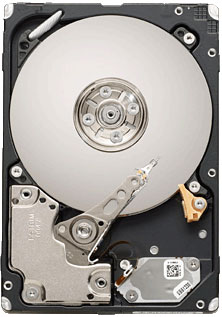 |
Key Features and Benefits
|
Specifications
Here is the specifications table to the Seagate Cheetah NS.2 600GB model SAS hard drive. The Cheetah NS.2 comes in 450GB and 600GB capacities, which means that the user has the choice to pick the capacity they really need. The user might be on a budget and want high-performance, but at the same time they would like to save some space in their rack and capacity is not an issue. By combining 4x 450GB hard drives in RAID0, it would provide the user with 1.8TB of hard drive space and would also save the customer quite a bit of money over the 600GB model.
| Specifications | |
|---|---|
| Model Number | ST9600204SS |
| Interface | 6-Gb/s SAS |
| Cache | 16MB |
| Capacity | 600GB |
| Areal density (avg) | 252Gbits/inch2 |
| Guaranteed Sectors | 1,172,123,569 |
| PHYSICAL | |
| Height (max) | 14.8mm (0.583 inches) |
| Width (max) | 70.0mm (2.75 inches) |
| Length (max) | 100.2mm (3.945 inches) |
| Weight (typical) | 208grammes (0.5 pounds) |
| PERFORMANCE | |
| Spindle Speed | 10,000 rpm |
| Sustained data transfer rate | 141Mb/s |
| Average latency | 3.0msec |
| Random read seek time | 3.89msec |
| Random write seek time | 4.54msec |
| Maximum interface transfer rate | 600Mbytes/sec |
| RELIABILITY | |
| MTBF | 2,000,000 hours |
| Annual Failure Rate | 0.44% |
| POWER | |
| 12V start max current | 1.65amps |
| 5V start max current | 0.86amps |
| Average idle current | 4.6watts |
| ENVIRONMENT | |
| Ambient Temperature | |
| Operating | 5°–55°C |
| Non-operating | -40°–70°C |
| Maximum operating temperature change | 30°C per hour |
| Maximum non-operating temperature change | 30°C per hour |
| Shock | |
| Operating Shock (max) | 40 Gs for 11msec |
| Non-operating Shock (max) | 400 Gs for 2msec |
| Vibration | |
| Operating vibration | 0.5Gs at <400Hz |
| Non-operating vibration | 3.0Gs at <500Hz |
| ACOUSTICS | |
| Acoustics (Idle Volume) | 3.0 bels |
Closer Look
And finally we can see that two Seagate Savvio 10K.4 hard drives stacked on each other are only a tiny bit taller than a standard 3.5″ drive. So if we stack two 3.5″ drives onto each other and compare that to three Seagate Savvio 10K.4 drives, can can tell that we are almost reaching the height of the two drives. Although the overall size of the drives is still a lot smaller than the three 2.5″ SAS drives together.
RAID Levels Tested
RAID 1
Diagram of a RAID 1 setup.

A RAID 1 creates an exact copy (or mirror) of a set of data on two or more disks. This is useful when read performance or reliability are more important than data storage capacity. Such an array can only be as big as the smallest member disk. A classic RAID 1 mirrored pair contains two disks (see diagram), which increases reliability geometrically over a single disk. Since each member contains a complete copy of the data, and can be addressed independently, ordinary wear-and-tear reliability is raised by the power of the number of self-contained copies.
RAID 1 performance
Since all the data exists in two or more copies, each with its own hardware, the read performance can go up roughly as a linear multiple of the number of copies. That is, a
RAID 1 has many administrative advantages. For instance, in some environments, it is possible to “split the mirror”: declare one disk as inactive, do a backup of that disk, and then “rebuild” the mirror. This is useful in situations where the file system must be constantly available. This requires that the application supports recovery from the image of data on the disk at the point of the mirror split. This procedure is less critical in the presence of the “snapshot” feature of some file systems, in which some space is reserved for changes, presenting a static point-in-time view of the file system. Alternatively, a new disk can be substituted so that the inactive disk can be kept in much the same way as traditional backup. To keep redundancy during the backup process, some controllers support adding a third disk to an active pair. After a rebuild to the third disk completes, it is made inactive and backed up as described above.
Diagram of a RAID 0 setup.

A RAID 0 (also known as a stripe set or striped volume) splits data evenly across two or more disks (striped) with no parity information for redundancy. It is important to note that RAID 0 was not one of the original RAID levels and provides no data redundancy. RAID 0 is normally used to increase
A RAID 0 can be created with disks of differing sizes, but the storage space added to the array by each disk is limited to the size of the smallest disk. For example, if a 120 GB disk is striped together with a 100 GB disk, the size of the array will be 200 GB.
RAID 0 failure rate
Although RAID 0 was not specified in the original RAID paper, an idealized implementation of RAID 0 would split I/O operations into equal-sized blocks and spread them evenly across two disks. RAID 0 implementations with more than two disks are also possible, though the group reliability decreases with member size.
Reliability of a given RAID 0 set is equal to the average reliability of each disk divided by the number of disks in the set:
The reason for this is that the file system is distributed across all disks. When a drive fails the file system cannot cope with such a large loss of data and coherency since the data is “striped” across all drives (the data cannot be recovered without the missing disk). Data can be recovered using special tools (see data recovery), however, this data will be incomplete and most likely corrupt, and recovery of drive data is very costly and not guaranteed.
RAID 0 performance.
While the block size can technically be as small as a byte, it is almost always a multiple of the hard disk sector size of 512 bytes. This lets each drive seek independently when randomly reading or writing data on the disk. How much the drives act independently depends on the access pattern from the file system level. For reads and writes that are larger than the stripe size, such as copying files or video playback, the disks will be seeking to the same position on each disk, so the seek time of the array will be the same as that of a single drive. For reads and writes that are smaller than the stripe size, such as database access, the drives will be able to seek independently. If the sectors accessed are spread evenly between the two drives, the apparent seek time of the array will be half that of a single drive (assuming the disks in the array have identical access time characteristics). The transfer speed of the array will be the transfer speed of all the disks added together, limited only by the speed of the RAID controller. Note that these performance scenarios are in the best case with optimal access patterns.
RAID 0 is useful for setups such as large read-only NFS servers where mounting many disks is time-consuming or impossible and redundancy is irrelevant.
RAID 0 is also used in some gaming systems where performance is desired and data integrity is not very important. However, real-world tests with games have shown that RAID-0 performance gains are minimal, although some desktop applications will benefit, but in most situations it will yield a significant improvement in performance.
RAID 5
Diagram of a RAID 5 setup with distributed parity with each color representing the group of blocks in the respective parity block (a stripe). This diagram shows left asymmetric algorithm.

A RAID 5 uses block-level striping with parity data distributed across all member disks. RAID 5 has achieved popularity due to its low cost of redundancy. This can be seen by comparing the number of drives needed to achieve a given capacity. RAID 1 or RAID 0+1, which yield redundancy, give only s / 2 storage capacity, where s is the sum of the capacities of n drives used. In RAID 5, the yield is equal to the Number of drives – 1. As an example, four 1TB drives can be made into a 2 TB redundant array under RAID 1 or RAID 1+0, but the same four drives can be used to build a 3 TB array under RAID 5. Although RAID 5 is commonly implemented in a disk controller, some with hardware support for parity calculations (hardware RAID cards) and some using the main system processor (motherboard based RAID controllers), it can also be done at the operating system level, e.g., using Windows Dynamic Disks or with mdadm in Linux. A minimum of three disks is required for a complete RAID 5 configuration. In some implementations a degraded RAID 5 disk set can be made (three disk set of which only two are online), while mdadm supports a fully-functional (non-degraded) RAID 5 setup with two disks – which function as a slow RAID-1, but can be expanded with further volumes.
In the example above, a read request for block A1 would be serviced by disk 0. A simultaneous read request for block B1 would have to wait, but a read request for B2 could be serviced concurrently by disk 1.
RAID 5 performance
RAID 5 implementations suffer from poor performance when faced with a workload which includes many writes which are smaller than the capacity of a single stripe; this is because parity must be updated on each write, requiring read-modify-write sequences for both the data block and the parity block. More complex implementations may include a non-volatile write back cache to reduce the performance impact of incremental parity updates.
Random write performance is poor, especially at high concurrency levels common in large multi-user databases. The read-modify-write cycle requirement of RAID 5’s parity implementation penalizes random writes by as much as an order of magnitude compared to RAID 0.
Performance problems can be so severe that some database experts have formed a group called BAARF — the Battle Against Any Raid Five.
The read performance of RAID 5 is almost as good as RAID 0 for the same number of disks. Except for the parity blocks, the distribution of data over the drives follows the same pattern as RAID 0. The reason RAID 5 is slightly slower is that the disks must skip over the parity blocks.
In the event of a system failure while there are active writes, the parity of a stripe may become inconsistent with the data. If this is not detected and repaired before a disk or block fails, data loss may ensue as incorrect parity will be used to reconstruct the missing block in that stripe. This potential vulnerability is sometimes known as the write hole. Battery-backed cache and similar techniques are commonly used to reduce the window of opportunity for this to occur.
RAID 6
Diagram of a RAID 6 setup, which is identical to RAID 5 other than the addition of a second parity block

Redundancy and Data Loss Recovery Capability
RAID 6 extends RAID 5 by adding an additional parity block; thus it uses block-level striping with two parity blocks distributed across all member disks. It was not one of the original RAID levels.
Performance
RAID 6 does not have a performance penalty for read operations, but it does have a performance penalty on write operations due to the overhead associated with parity calculations. Performance varies greatly depending on how RAID 6 is implemented in the manufacturer’s storage architecture – in software, firmware or by using firmware and specialized ASICs for intensive parity calculations. It can be as fast as RAID 5 with one fewer drives (same number of data drives.)
Efficiency (Potential Waste of Storage)
RAID 6 is no more space inefficient than RAID 5 with a hot spare drive when used with a small number of drives, but as arrays become bigger and have more drives the loss in storage capacity becomes less important and the probability of data loss is greater. RAID 6 provides protection against data loss during an array rebuild; when a second drive is lost, a bad block read is encountered, or when a human operator accidentally removes and replaces the wrong disk drive when attempting to replace a failed drive.
The usable capacity of a RAID 6 array is the total number of drives capacity -2 drives.
Implementation
According to SNIA (Storage Networking Industry Association), the definition of RAID 6 is: “Any form of RAID that can continue to execute read and write requests to all of a RAID array’s virtual disks in the presence of any two concurrent disk failures. Several methods, including dual check data computations (parity and Reed Solomon), orthogonal dual parity check data and diagonal parity have been used to implement RAID Level 6.”
TESTING & METHODOLOGY
There are some things to keep in mind about testing the Seagate Savvio 10K.4 Drives. The first thing is that they’re not really designed for this purpose, which is what makes it fun. Second, they’re designed for a server environment with features that we can’t really test. For instance, they’re specifically designed to be low noise and have anti-vibrational features and we can tell you that they accomplish those quite nicely. They are entirely quiet in operation, and seem to be vibration free.
Another important thing to remember is that we are using a LSI 3ware SAS 9750-8i hardware RAID controller with a built in 800MHz processor and 512MB dedicated DDR2 800MHz RAM. It’s a very capable hardware RAID controller and it provides a bunch of different possible RAID configurations.
We chose to do testing on RAID 0 with 3 drives on a Xeon based system and a Core i7 bases system. We tested every level of RAID0 that we possibly could given our setup. We also tested one single SAS hard drive with the RAID card to see how one drive performs and what are the advantages of 3 drives compared to just 1. And finally we also took a look at RAID 5 where we get the capacity of 2 hard drives but still work in a very similar way as RAID0, except it has enough information of each hard drive on each disk that in case one drive fails, the system is still capable of functioning.
We did a fresh load of Windows 7 Pro on a boot drive, then because much of the testing on Hard Drive and RAID Array’s is destructive we left each Array blank and tested them in that manner. If you try to do any write testing on an Array, a lot of utilities will destroy the data on them and you’d end up loading Windows 7 three times for each test. That’s just not feasible. Then, after we tested all the different arrangements we wanted to test, we fired up what we suspected to be the most popular enthusiast RAID array (RAID0) and loaded Windows 7 Pro on it and did some real life testing with an 3xRAID0 array.
Test Rig
| Test Rig | |
| Case Type | Zalman MS-1000 H1 |
| CPU | Intel Xeon X3470 2.66GHz @ 3.9GHz. |
| Motherboard | Asus P7P55 WS SuperComputer Motherboard LGA1156 |
| Ram | OCZ Gold-Series 4x2GB (8GB) DDR3-12800 1600MHz Memories |
| CPU Cooler | Thermalright Venomous X CPU Cooler with two SilenX 120mm fans. |
| Hard Drives |
3x Seagate Savvio 10K.4 600GB 2.5″ 6Gb/s Hard Drives 4x Seagate Cheetah NS.2 10K 600GB 3.5″ 6Gb/s Hard Drives |
| Optical | LG Blu-Ray Disk Drive |
| GPU |
BFG GeForce GTX 275 OC, Thermalright HR-03 GTX VGA Cooling with 120mm SilenX fan. |
| Case Fans |
4x Noctua NF-P12 120mm Fans on Bottom, Back, and Top 1x 92mm Zalman Fan on Hard Drive compartment, Front |
| Docking Stations | None |
| Testing PSU | Seasonic X-Series 750W 80Plus Gold Modular Power Supply |
| Legacy | None |
| Mouse | Logitech G5 Gaming Mouse |
| Keyboard | Logitech G15 Gaming Keyboard |
| Gaming Ear Buds |
None |
| Speakers | Creative 2.1 Speaker Setup. |
Test Suite
|
Benchmarks |
|
HDTach |
|
HD Tune Pro |
|
IOMeter |
|
Adobe After Effects CS4 |
|
Uncompressed HD Footage Video Playback |
HDTach
Here are the first benchmark results that came in comparing the Savvio 10K.4 drives to the previously reviewed Cheetah NS.2 drives. I would like to note, that the burst speeds should not be taken seriously. HDTach seems to bypass the actuall platter tests for the Burst Speeds and seems to be using the built in cache the SAS drives come with for measuring burst speeds. It would be totally unrealistic to get results like these with hard drives rated at 150mb/s transfer spees. To be honest here, I was a bit dissapointed in seeing the scalability of the drives especially when they were used in RAID. If one drive performs at 120MB/s in average, 3x 100% improvement would be 360MB/s. But that’s quite unrealistic too, considering that haveing the drives in RAID usually doesn’t work quite as well as we might expect. So if you have a single drive and you would get another one for a RAID 0 configuration, you wouldn’t fully see a double preformance. It could get close, but don’t expect 100% improvement. However, if we do the calculation on these drives and take the 3x Seagate Savvio 10K.4 RAID 0 configuration into account, we only get about 54% improvement over having only one drive. So what we can see form these results is that one Seagate Savvio 10K.4 drive can keep up with a 3.5-inch Seagate Cheetah NS.2 hard drive, but once it comes to RAID, the Cheetah NS.2 wins.
Very similar situation in this second benchmark. On the 32MB benchmark a single Savvio Drive fell behind a bit, but these speeds are still over the standard speeds we would get with a 7200RPM 3Gb/s hard drive. So, still not too bad, but could be a bit better. When it comes to RAID, the actuall performance is much better. All of a sudden we start seeing 139.2MB/s performance increase from one SAS drive to three SAS drives. Now the Savvios are starting to shine, but they are unfortunately still a bit behind the Cheetah NS.2 drives. We did see about 133% performance boost over one single drive however, which is much better than just a 54% improvement we got in the previous benchmark.
HD Tune Pro
HD Tune Pro is one of our favorite applications to run because it has never let us down. For a single Savvio 10K.4 drive we see an average data rate of 104.3MB/s while for the Cheetah NS.2 drives we saw 101.3MB/s. The minimum performance of the Savvios are also about 10MB/s higher than the Cheetah NS.2 results. It’s nice to see that the minimum is at around 70MB/s because this is about the average speed we see in normal consumer based Hard Drives. This just shows that while this is the average speed on consumer hard drives, the Savvio’s lowest speed actually hits these s and it’s average speed is quite a bit higher than what other hard drives would be able to do. The RAID advantage over a single drive is not too big as we have seen on the first benchmark we have ran, and the Cheetah takes the lead by more than double the performance, but the maximum performance of the drives, stack up quite nicely, acheaving up to 243MB/s.
IOMeter
IOMeter is what the industry likes to use to measure the performance of their hard drives, so we went ahead and ran a well over 10 hour benchmark in 6 different ways to get accurate benchmark results for each drive. Since the benchmark takes a lont time to run, we only ran it once for each test.
Ok, so this graph shows us the actual total Input/Output Operations Per Second that each of these drives give us. The 4x Seagate cheetah NS.2 RAID 5 configuration works very similarly to a 3x Seagate Cheetah NS.2 RAID 0 configuration. So by this we can see that the 3x Seagate Savvio 10K.4 RAID 0 configuration is about 60% of the performance the Cheetah NS.2 gives us. If we look at it in a different way, on the previous pages we saw that one 3.5-inch drive takes up about the size of two 2.5-inch Savvio 10K.4 drives in height. Of course the 3.5-inch drives are also larger in lenght and width, so overall, the 2.5-inch drives are much smaller than the 3.5-inch drives. If we stack three 3.5-inch drives, that would be about five to six 2.5-inch drives stacked next to the three 3.5-inch drives and they would still be around the same height. If we do some math, the performance of three Savvio 10K.4 drives is around 700 IOPS, and about 500 IOPS for 2 drives. That would be about 1200 IOPS for 5 drives. So from this we can predict that with five 2.5-inch drives we would achieve the speed of three 3.5-inch drives. Both of these configurations would be about the same size in height, but the 2.5-inch drives would still win in width and lenght sizes. This puts the 2.5-inch drives as the king over the 3.5-inch drives even if cost is more expensive. So speed can be achieved just as well with the Savvio 10K.4 drives as with the Cheetah NS.2 drives, except the Savvio 10K.4 drives would give you a lot more capacity the user can work with.
The MB/s performance test showed exactly the same pattern as the IOPS benchmark. So we can conclude with the same predictions as we have done on the IOPS benchmark above.
Adobe After Effects CS4
Running a real life benchmark and seeing how fast an uncompressed video would render to the Savvio Drives was quite dissapointing, but still performs better than consumer hard drives. With 3x Seagate Savvio 10K.4 drives, we were barely able to beat a single Seagate Cheetah NS.2 hard drive performance wise in write speed. Comparing just a single hard drive setup between the Savvio 10K.4 and the Cheetah NS.2 hard drives, there was about a minute and 30 seconds delay in rendering speed while using the same hardware with both hard drives.
Benchmark Screenshots
These are screenshots of the benchmarks we have performed. Since just graphs cannot really shows the actual performance of these hard drives with the LSI 3Ware SAS 9750-8i RAID controller card, we have also included this section with the benchmark results screenshots.
Single SAS Benchmarks
HDTach
Click Image for a Larger One
HD Tune Pro
IOMeter
After Effects CS4 – Uncompressed Video Rendering
Uncompressed HD Video Playback
Click Image for a Larger One
In our Uncompressed HD Video Playback tests we just let a over 40GB uncompressed HD video play that was about 5 minutes long. We went into resource monitor to see the hard drive usage and how well can one single Seagate Savvio 10K.4 drive keep up with an uncompressed HD video. We saw the disk usage bump all the way up to 126MB/s which shows that even a single drive has a potential at 2.5-inches. Unfortunately, the video did lag a tiny bit because uncompressed HD video requires a bit higher data rate than 126MB/s.
3x RAID 0 Benchmarks
HDTach
Click Image for a Larger One
HD Tune Pro
IOMeter
After Effects CS4 – Uncompressed Video Rendering
Uncompressed HD Video Playback
Click Image for a Larger One
With three Seagate Savvio 10K.4 drives, we noticed that one uncompressed HD video requires about 148MB/s data rate so it owuld not lag. We measured the speeds through Resource Monitor. When we opened up another instance of the video, we started seeing a few lags. If you remember the results on the previous pages. The highest speed we were able to achieve in a RAID 0 configuration was around 244MB/s average. This was measured in HDTach in the 32mb benchmark. If we put some math into this, if one video requires 148MB/s transfer speed, two videos would require about 300MB/s transfer speed. Since the average transfer speed with three Savvio 10K.4 drives is only around 244MB/s, we will start seeing the second instance of the uncompressed HD video suffer, because it requires an additional 56MB/s transfer speed.
3x RAID 5 Benchmarks
HDTach
Click Image for a Larger One
HD Tune Pro
IOMeter
After Effects CS4 – Uncompressed Video Rendering
Uncompressed HD Video Playback
Click Image for a Larger One
In the last test, the three Savvio 10K.4 drives in RAID 5 configuration, we ran the same test and got very similar results. The measurement was only 3mb off from the previous test, but this is understandable because a hard drive will alwasy read the information differently. There are many other components that also determine the exact performance of the drives as well. But we can pretty much explain the same findings on this setup as the previous setup, except in this one we would 95MB/s transfer rate to achieve smooth playback. So as you might understand, this was a bit slower and a lot more laggier than the RAID 0 configuration.
Conclusion – Seagate Savvio 10K.4
It is important to understand that 2.5-inch SAS based drives have their best performance increase in random Input/Output Operations Per Second, because of the shorter distance needed for the arm to travel through the disks compared to 3.5-inch SAS drives. But, as we have seen in the benchmarks, this was not quite true. It seemed as if the 2.5-inch Savvio drives performed much slower to their rival 3.5-inch Cheetah drives. This is because the idea we explained on the beginning of this paragraph does not always hold the case as a “rule” because “the form factor limitations of power/magnetic head stack assembly make it to where the arm can often not perform “as quickly” as a 3.5-inch drive that has more power available.”
So according to the results, the Savvio 10K.4 drives did lack in performance over the Cheetah NS.2 drives, but the main goal in these drives was not specifically performance, but the capacity to size ratio. This is the first time we saw a 2.5-inch based hard drive have a 600GB capacity. So if we look at the advantages of the Savvio 10K.4 drives over the Cheetah NS.2 drives, one of the clearest advantages would be the size. The Savvio 10K.4 drives are 70% smaller than the standard 3.5-inch drives, which allows users to run a lot more Savvio 10K.4 drives in the same rack versus the Cheetah NS.2 drives. This will not only provide larger capacity, but we could also see the actuall performance of the drives outperforming the Cheetah NS.2 drives. If they do not outperform the Cheetah NS.2 drives, we can definately expect about the same performance when all the space is used up with the Savvio 10K.4 drives as the previous 3.5-inch rack. This would require us to test hundreds of drives to fully see the performance to size requirement ratio between the two drives, but nonethless, this is what we could predict from our benchmarks.
To sum everything up, we were quite pleased with the overall performance of these drives, considering that other 2.5″ drives don’t run as fast as these, but to be honest, I was expecting a bit more. The capacity was a shock. When we first heard about these drives, we were not sure if either Seagate has a typo on their site or if our eyes were going bad. But it turned out to be true. The first 600GB 2.5-inch drives are now out, and this certenly makes it possible for larger corporations to upgrade their overall capacity that can be used without having to go out and buy more hard drive racks.
On the downside, we did find the drives to heat up quite easily, and this is expected with 10,000RPM 2.5-inch drives, but they just seemed to get a bit way too hot. Without a fan, we saw the temperatures sky rocket to 56C under 20C ambient temperatures. When we added a Noctua NF-P12 120mm fan and let it blow air at the drives at its full speed, the temperatures dropped to about 38-40C. This is not too bad, but plan on geting some good ventilation for your drives if you are getting a few of these drives and if you are putting them close to each other. I would say use at least one 120mm fan for 4 drives and 2 fans for 8 drives and so on to extend the life of the drives. This is of course only our opinion, but remember, the lower the temperatures are, the less likely something will go bad in the long run.
| OUR VERDICT: Seagate Savvio 10K.4 600GB 6Gb/s Hard Drives | ||||||||||||||||||
|
||||||||||||||||||
| Summary: When we first heard abou the Seagate Savvio 10K.4 600GB 2.5″ 10,000RPM 6Gb/s Serial Attached SCSI hard drives, we were eager to test the performance vs. the Cheetah drives. While performance was not what we expected, this is the first time we saw such capacity and speed at this small form factor size, and overall the Seagate Savvio 10K.4 600GB 2.5″ 10,000RPM 6Gb/s Serial Attached SCSI hard drives deserve a 9 out of 10 points and Bjorn3D’s Golden Bear Award! |
| Product Name | Price |
| Seagate Cheetah NS.2 600GB 3.5″ SAS 6Gb/s Internal Hard Drive | $533 |
| Seagate Savvio 10K.4 600GB 2.5″ SAS 6Gb/s Internal Hard Drive | $616 |
| LSI 3ware SAS 9750-8I KIT 4PORT 6GB SATA+SAS PCIE 2.0 512MB | $573 |
 Bjorn3D.com Bjorn3d.com – Satisfying Your Daily Tech Cravings Since 1996
Bjorn3D.com Bjorn3d.com – Satisfying Your Daily Tech Cravings Since 1996
